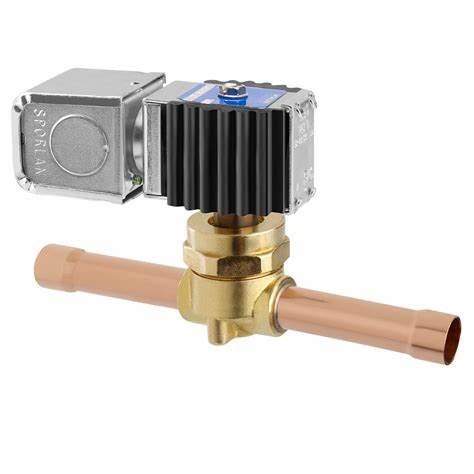Understanding Solenoid Valves: The Key to Automated Fluid Control
2025-02-12
In modern industries, automation plays a crucial role in increasing efficiency and precision. Among the various components that make automation possible, the solenoid valve stands out as an essential device for controlling fluid flow in various systems. Whether it’s regulating water, gas, oil, or other fluids, solenoid valves provide a reliable and efficient solution. In this blog post, we will dive deep into what solenoid valves are, how they work, and why they are so widely used across different industries.
What is a Solenoid Valve?
A solenoid valve is an electromechanical valve used to control the flow of liquids or gases. It uses a solenoid (an electromagnet) to open or close the valve, hence its name. The valve is typically connected to a power source, and when the solenoid is activated by an electric current, it generates a magnetic field that either opens or closes the valve, controlling the flow of the fluid.
The basic design of a solenoid valve includes a coil, a plunger or armature, and a valve body with a port. When the coil is energized, the plunger moves, causing the valve to either open or close, depending on the design. This allows the system to control the flow of fluids based on electrical signals, making solenoid valves ideal for automated systems.
How Does a Solenoid Valve Work?
Solenoid valves are relatively simple in design but highly effective in their operation. The basic working principle involves electromagnetic force. Here's how it works:
1. Power Supply and Activation:
When an electric current flows through the solenoid coil, it creates a magnetic field that pulls or pushes a plunger or armature inside the valve body.
2. Valve Operation:
The movement of the plunger changes the position of the valve, either opening or closing it. The valve’s function (open or closed) depends on whether it is normally open (NO) or normally closed (NC).
3. Fluid Control:
When the valve opens, fluid can flow through the valve port; when it closes, the flow is blocked. The solenoid's activation allows for fast, precise control of fluid flow without the need for manual intervention.
4. Deactivation:
When the electric current is switched off, the magnetic field dissipates, and the plunger returns to its original position, closing or opening the valve as needed.
Types of Solenoid Valves
There are different types of solenoid valves, and the type you choose depends on the specific requirements of the application. Some common types include:
1. Two-Way Solenoid Valve
The most basic type, the two-way solenoid valve has two ports: one for fluid to enter and one for it to exit. It is typically used to control the flow of a single fluid in either an open or closed state.
2. Three-Way Solenoid Valve
A three-way solenoid valve has three ports and can be used for diverter or selector functions. It can switch the flow between two output ports or mix fluid from two inputs into one output.
3. Four-Way Solenoid Valve
Common in pneumatic systems, the four-way solenoid valve is often used to control double-acting actuators, with four ports and two positions to control the flow of compressed air or other gases.
4. Pulse Solenoid Valve
Pulse solenoid valves are designed to release short bursts or pulses of fluid and are commonly used in systems where precise, quick bursts are required, such as in cleaning or irrigation systems.
5. Proportional Solenoid Valve
These valves allow for variable flow control rather than a simple open or closed position. By adjusting the current, the valve can modulate the flow of fluid in proportion to the input signal.
Applications of Solenoid Valves
Solenoid valves are used in a wide range of industries and applications. Some of the most common include:
1. Automated Irrigation Systems
In irrigation systems, solenoid valves control the water flow to different parts of a garden or agricultural area. The solenoid valve is activated or deactivated by a timer or moisture sensors to ensure that water is delivered as needed.
2. HVAC Systems
In heating, ventilation, and air conditioning (HVAC) systems, solenoid valves are used to regulate the flow of refrigerants, hot water, or coolants. They help control temperature and pressure within the system, improving efficiency.
3. Water Treatment Plants
In water treatment plants, solenoid valves control the flow of water through filtration, sterilization, and chemical treatment processes. They ensure that the right amount of chemicals or disinfectants is added at the appropriate time.
4. Medical Equipment
Solenoid valves are also used in medical equipment such as oxygen regulators, anesthesia machines, and infusion pumps. Their precise control of gas or fluid flow is crucial for ensuring patient safety and comfort.
5. Oil and Gas Industry
In the oil and gas industry, solenoid valves help control the flow of oil, gas, or chemicals through pipelines, machinery, and safety systems. They ensure that the flow is regulated, even in high-pressure conditions.
6. Food and Beverage Industry
Solenoid valves are used in food and beverage production lines, where they control the flow of ingredients, liquids, or gases. This helps maintain consistency and ensures that production is automated and efficient.
Benefits of Solenoid Valves
Solenoid valves offer several benefits, making them a popular choice in various industrial and commercial applications. Some of the key advantages include:
1. Automation and Remote Control
Solenoid valves can be controlled remotely using electric signals, making them ideal for automated systems. This reduces the need for manual intervention and enhances system efficiency.
2. Precise Control
The electromagnetic mechanism allows for precise control of fluid flow, which is essential in applications where accurate measurements are critical.
3. Reliability and Durability
Solenoid valves are known for their durability, offering a long operational life with minimal wear and tear. They are built to withstand the demands of high-pressure, high-temperature, and corrosive environments.
4. Quick Response Time
Solenoid valves operate quickly, offering almost instantaneous response times. This is essential in applications where timely fluid control is necessary to ensure proper system function.
5. Cost-Effectiveness
Due to their simple design and reliable operation, solenoid valves are cost-effective compared to other types of fluid control valves. Their long lifespan and low maintenance needs further contribute to their cost-effectiveness.
Conclusion
Solenoid valves are an indispensable component in a wide range of industries and applications. Their ability to provide precise, reliable, and automated fluid control has made them essential in systems that require efficient fluid management. From irrigation systems to complex industrial processes, solenoid valves offer enhanced control, safety, and efficiency, making them a critical piece of modern automation technology. Understanding their operation and choosing the right type for your application can help you optimize the performance and reliability of your systems.



